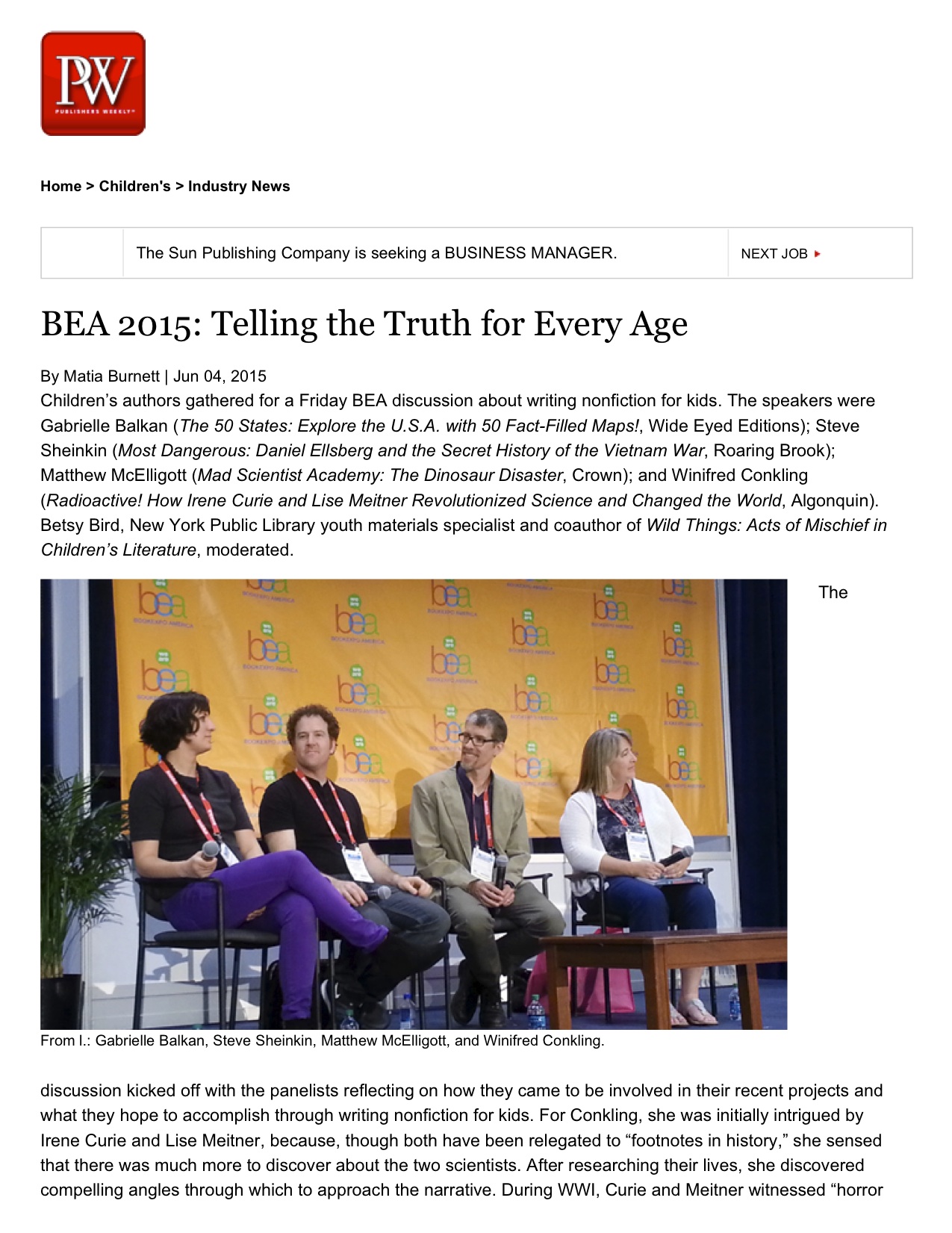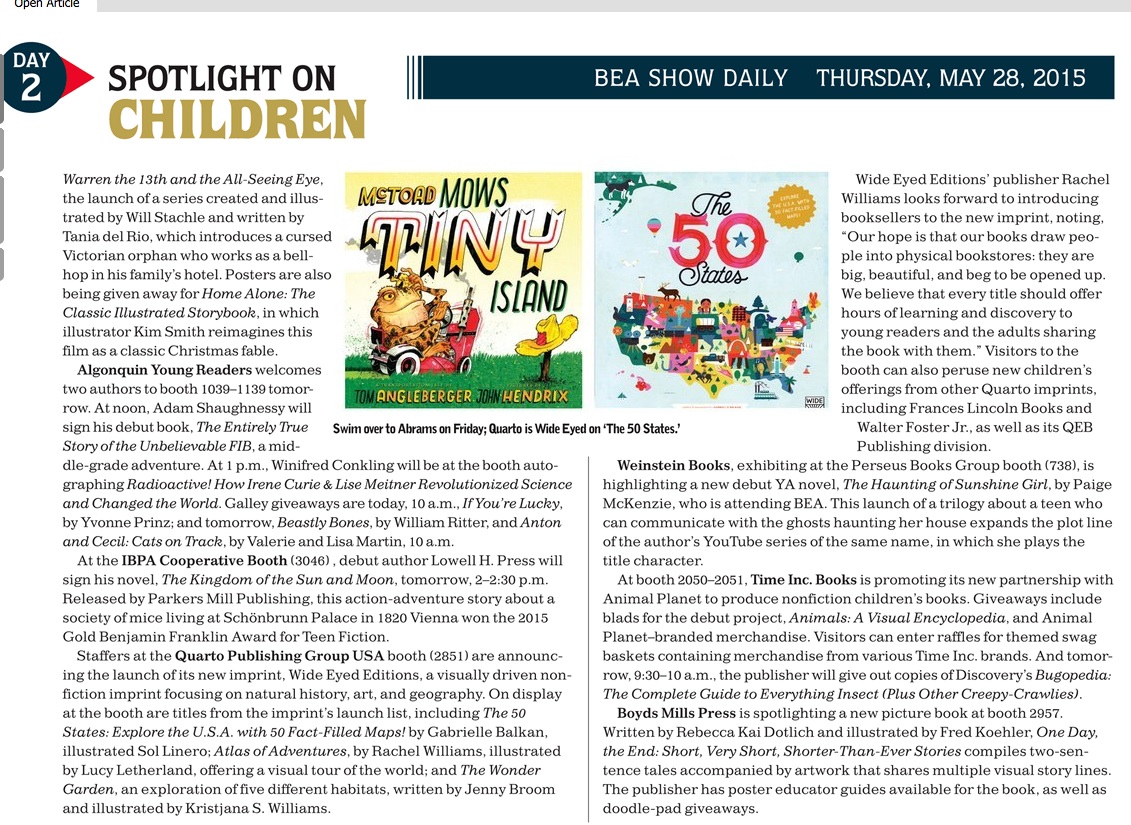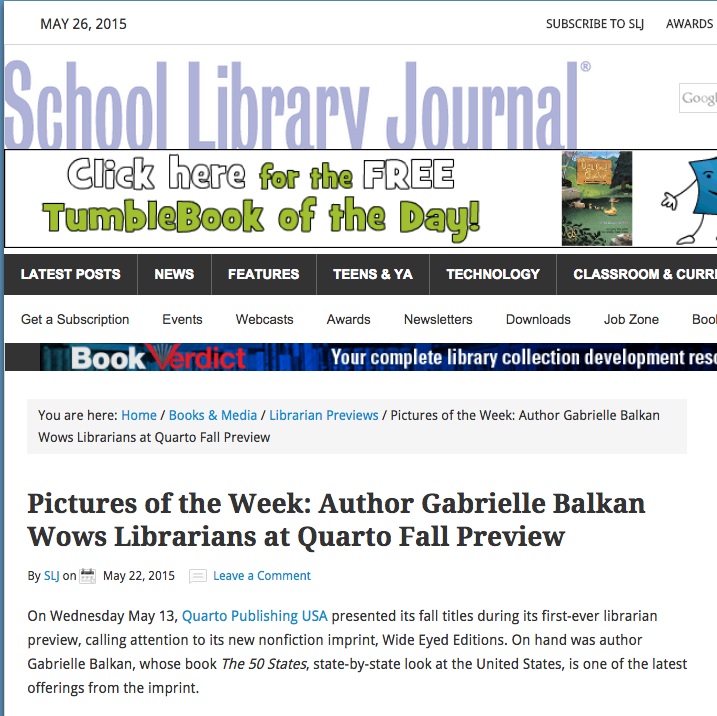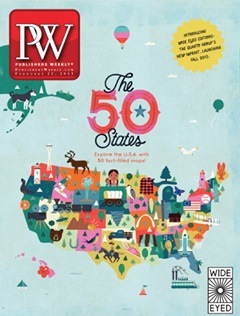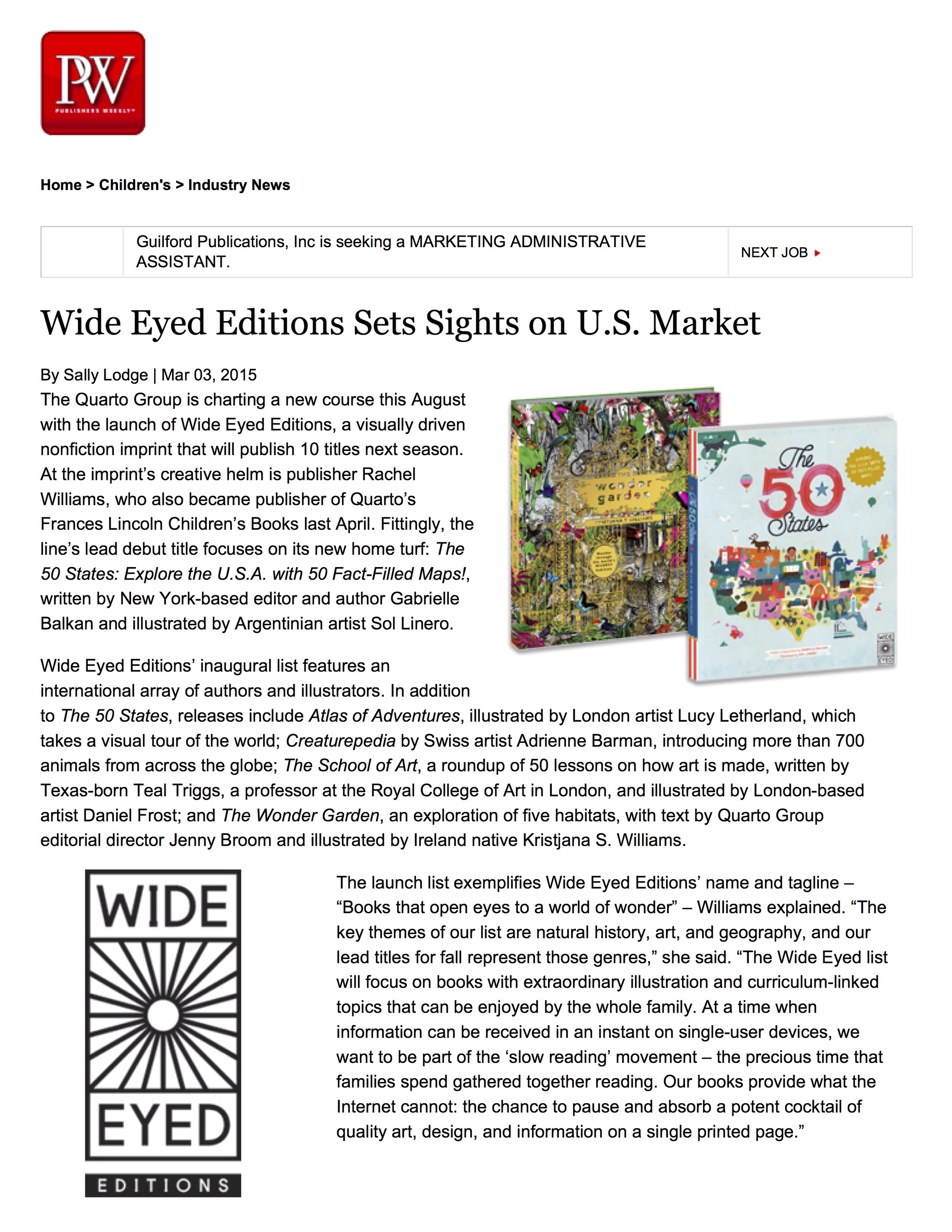PRESS
Publisher's Weekly, Book Expo America: Telling the Truth For Ever Age Nonfiction Panel, June 4, 2015
BEA 2015: Telling the Truth for Every Age
By Matia Burnett | Jun 04, 2015
Children’s authors gathered for a Friday BEA discussion about writing nonfiction for kids. The speakers were Gabrielle Balkan (The 50 States: Explore the U.S.A. with 50 Fact-Filled Maps!, Wide Eyed Editions); Steve Sheinkin (Most Dangerous: Daniel Ellsberg and the Secret History of the Vietnam War, Roaring Brook); Matthew McElligott (Mad Scientist Academy: The Dinosaur Disaster, Crown); and Winifred Conkling (Radioactive! How Irene Curie and Lise Meitner Revolutionized Science and Changed the World, Algonquin). Betsy Bird, New York Public Library youth materials specialist and coauthor of Wild Things: Acts of Mischief in Children’s Literature, moderated.
The From l.: Gabrielle Balkan, Steve Sheinkin, Matthew McElligott, and Winifred Conkling.
The discussion kicked off with the panelists reflecting on how they came to be involved in their recent projects and what they hope to accomplish through writing nonfiction for kids. For Conkling, she was initially intrigued by Irene Curie and Lise Meitner, because, though both have been relegated to “footnotes in history,” she sensed that there was much more to discover about the two scientists. After researching their lives, she discovered compelling angles through which to approach the narrative. During WWI, Curie and Meitner witnessed “horror The Sun Publishing Company is seeking a BUSINESS MANAGER. NEXT JOB on the battlefield” while serving as nurses operating Xray equipment, which caused them to become pacifists. Yet in an ironic twist, their research into radioactivity contributed to the making of the atomic bomb. Conkling seeks out such psychological complexities when researching her subjects; once she finds that tension or intrigue, she knows she’s onto “a much bigger story.”
Sheinkin joked that, since he used to write textbooks, “I’m trying to make amends for that” by writing riveting accounts of reallife events. He calls Most Dangerous, about the man who leaked the Pentagon Papers, a “complex and big story... a natural thriller about a consummate insider who decides to expose the truth.” For Balkan, the impetus behind writing The 50 States: Explore the U.S.A. with 50 FactFilled Maps!, illustrated by Sol Linero, was to create a book about the U.S. that is a mix of “essential info” and material that readers would never have come across before, broadening the concept of a simple atlas to be something much more encompassing.
McElligott began writing Mad Scientist Academy: The Dinosaur Disaster because he was just following his bliss: “I love to draw monsters, to learn about science, and I love the challenge of presenting information in an engaging and fun way,” McElligott said. The Dinosaur Disaster is the first in a series about a school run by Dr. Cosmic with a student body of monster kids who must use science to avoid situations like robotic dinosaurs coming to life and wreaking havoc.
The authors discussed other challenges that are unique to writing nonfiction for young readers. For Conkling, she struggles with reigning in the amount of information she often uncovers during the research phase. It’s easy to become distracted by material that isn’t necessarily germane to a project at hand, she said, and she often has to remind herself: “What’s the arc of this story?” She admitted that, while some material might not make it into the final product, “I write it in because it excites me, and then delete.” Even if some information does not end up in the book, she makes a point to use resources that readers themselves can locate to learn more about the subject, such as the Gutenberg Project. That way, if a reader wants to, they can research the topic more indepth and on their own terms.
McElligott said he struggles with striking a balance between storyline and factual information in his books. One of the trickiest tasks for him is presenting scientific material through dialogue in a way that feels natural to readers. He also tries to avoid having the story feel like it is being imposed on a science lesson. It’s a challenge that all of the panelists said they encounter: seeking the sweet spot between telling the truth and entertaining readers. Above all, Conkling believes in honoring what actually happened with accurate, detailed information. “Kids have access to so much info,” she said. Nonfiction books should serve as models and tools through which kids can become “discerning readers, learners, and processors of history.” Sheinkin said he understands how important it is to provide accurate content, and remarked how easy it would be to simply make something up if it would fit well into the context, though it isn’t necessarily the truth. “A million great things are said that aren’t recorded,” he noted, adding that it might be tempting to just fill in the blanks. And yet: “it’s cheating. You can’t cross that line.”
Sometimes, the truth can really throw a wrench in a gameplan, as McElligott explained. While he was finishing writing and illustrating Dinosaur Disaster, paleontologists made revisions to what they had previously understood a particular dinosaur to look like: “300 million years they have to decide what this dinosaur looks like,” he joked. As a result of this new scientific consensus, McElligott had to go back and revise all of the images of the dinosaur in question.
Bird brought up the issue of whether the authors feel they have to leave out content that might not be appropriate for young readers. Generally speaking, the authors feel that there are very few limitations placed on them in terms of what they can include in their books. For Sheinkin, he pushes content as far as he can in terms of complexity. While he’s had some adults tell him that they think his books are too dense, he’s never had a young reader say that. For Balkan, though The 50 States is primarily “celebratory in content,” there are elements of darkness from U.S. history that are also included in the book. In those cases, it becomes a matter of angle and perspective. Balkan’s approach was to “focus on the heroes in those moments,” or individuals who made positive impacts under bleak circumstances.
In closing, the speakers spoke about their own relationships with nonfiction and history growing up. In fact, none said they were particularly voracious readers of nonfiction. It was often within the context of fiction that the authors recalled becoming intrigued by history. McElligott noted how interested he was in “elements in fictional stories that are, in fact, the truth.” Sheinkin loved reading historical novels; Balkan recalled that, while “history felt very flat to me growing up,” her interest was sparked by depictions of the past in books like Little House on the Prairie. She recalls being fascinated by what characters were eating. It led her to start thinking about how history isn’t something dead from the past, but is filled with moments and choices, some small, others pivotal. “History is happening now,” she said.
School Library Journal, Pictures of the Week: Author Gabrielle Balkan Wows Librarians at Quarto Fall Preview, May 22, 2015
On Wednesday May 13, Quarto Publishing USA presented its fall titles during its first-ever librarian preview, calling attention to its new nonfiction imprint, Wide Eyed Editions. On hand was author Gabrielle Balkan, whose book The 50 States, state-by-state look at the United States, is one of the latest offerings from the imprint.
“These are the sorts of books to buy as gifts and are made to be coveted, cherished objects that provide hours of learning and discussion.”
Publisher's Weekly, "Wide Eyed Editions Sets Sights on U.S. Market", Sally Lodge, March 3, 2015
The Quarto Group is charting a new course this August with the launch of Wide Eyed Editions, a visually driven nonfiction imprint that will publish 10 titles next season. At the imprint’s creative helm is publisher Rachel Williams, who also became publisher of Quarto’s Frances Lincoln Children’s Books last April. Fittingly, the line’s lead debut title focuses on its new home turf: The 50 States: Explore the U.S.A. with 50 Fact-Filled Maps!, written by New York-based editor and author Gabrielle Balkan and illustrated by Argentinian artist Sol Linero.
Wide Eyed Editions’ inaugural list features an international array of authors and illustrators. In addition to The 50 States, releases include Atlas of Adventures, illustrated by London artist Lucy Letherland, which takes a visual tour of the world; Creaturepedia by Swiss artist Adrienne Barman, introducing more than 700 animals from across the globe; The School of Art, a roundup of 50 lessons on how art is made, written by Texas-born Teal Triggs, a professor at the Royal College of Art in London, and illustrated by London-based artist Daniel Frost; and The Wonder Garden, an exploration of five habitats, with text by Quarto Group editorial director Jenny Broom and illustrated by Ireland native Kristjana S. Williams.
The launch list exemplifies Wide Eyed Editions’ name and tagline – “Books that open eyes to a world of wonder” – Williams explained. “The key themes of our list are natural history, art, and geography, and our lead titles for fall represent those genres,” she said. “The Wide Eyed list will focus on books with extraordinary illustration and curriculum-linked topics that can be enjoyed by the whole family. At a time when information can be received in an instant on single-user devices, we want to be part of the ‘slow reading’ movement – the precious time that families spend gathered together reading. Our books provide what the Internet cannot: the chance to pause and absorb a potent cocktail of quality art, design, and information on a single printed page.”
Williams, who started the Big Picture Press list in 2013 (for Templar in the U.K. and Candlewick in the U.S.), plans to split her time between the Quarto Group’s offices in London and New York. In 2016, she will grow the new imprint to an output of 18 titles, aimed at audiences ages 2-10, which will be commissioned, copyedited, and Americanized by a transatlantic team, including Broom in London and Balkan in New York. Williams anticipates that eventually approximately half of the imprint’s releases will originate in the U.S. and half in the U.K., and that the list “will definitely have the feeling of an American list, but with a global perspective.”
With Wide Eyed Editions’ focus on illustration and design, Williams anticipates that the imprint’s books will have appeal in specialty markets as well as in traditional book trade outlets.
“These are the sorts of books to buy as gifts and are made to be coveted, cherished objects that provide hours of learning and discussion,” she said. “Many titles on the launch list have sold in up to eight languages ahead of publication, which is encouraging. It’s an exciting time for nonfiction.”
Returning to the name she chose for the new imprint, Williams added that Wide Eyed also provides an acronym indicative of the teamwork this publishing venture involves. “ ‘WE’ stands for how our books are made,” she said. “They are a true collaboration between the artist, author, commissioner, designer, editor, and the sales and marketing teams. All of our books have a team of champions behind them, and that’s why I believe they will shine.”
“They are big, beautiful books that beg to be opened. ”
Publisher's Weekly, Cover Ad, February 23, 2015
Publisher's Weekly, "Quarto USA Ramps Up Its Children’s Publishing", February 6, 2015
Quarto Publishing Group USA, the U.S. publishing arm of the U.K.-based Quarto Group, which is already well known for publishing and distributing illustrated books and other products under more than a dozen imprints, is expanding in a direction that will further enhance its expertise in that area. Quarto USA is moving aggressively into children’s book publishing in 2015 by releasing 176 children’s frontlist titles for both the trade and school/library markets.
The titles will be released under four imprints, up from Quarto USA’s 20 releases in 2014 under the Walter Foster Jr. imprint. Besides Walter Foster Jr., Quarto USA will release children’s books under the Frances Lincoln Children’s Books and QEB Publishing imprints, as well as under its newest imprint, Wide Eyed Editions, which will launch in fall 2015.
“There aren’t many publishers who go from zero to 100 in one year,” Amy Yodanis, Quarto USA marketing director, said. “We’re going from not being a company that you would look at for children’s books to being a serious force in children’s book publishing.”
Marcus Leaver, Quarto Group’s CEO, who is based in London, said that when he assumed his position at Quarto in 2012, he quickly realized that the company was “under strength regarding its weighting” in its children’s portfolio, and that there was a “significant gap” in the unlicensed market. “The key characteristics of children’s books today play to our undoubted strengths in creating products that are highly visual, largely nonfiction, and with very high production values,” he noted, explaining that under his direction, the company immediately invested in pumping up the children’s publishing portfolio.
“Our children’s businesses have grown faster than the overall publishing businesses,” Leaver said, “and now represent just under 20% of the Group’s publishing revenues.”
“We believe children’s books are witnessing a golden age of prosperity in markets we publish into,” Leaver added. “Our established reputation and geographical flexibility place Quarto in a strong position to take advantage of the real growth opportunities enjoyed by children’s publishing.” Quarto Group’s goal, according to Leaver, is that children’s book publishing will make up 25% of the company’s net revenues within the next two or three years. In 2014, Quarto Group’s publishing revenues were approximately $140 million; of that figure, $70 million represented Quarto USA’s publishing revenues.
Walter Foster Jr. releases include activity, craft, and reference books, and kits. Walter Foster Jr. has already launched its Learn to Draw series, and its 2014 release You Can Draw Cartoon Animals, by Christopher Hart, has sold 100,000 copies. In 2015, 45 titles will be released under the Walter Foster Jr. imprint, up from 20 in 2014. Frontlist includes its lead title, 101 Things to Do Before You Grow Up, and the launch of two new series this year. Walter Foster Jr. will also publish licensed titles in its Learn to Draw series, including DreamWorks’Madagascar and Disney’s Frozen.
On March 1, Quarto USA will also begin distributing stateside children’s books from Quarto’s U.K. publishing division, Frances Lincoln Children’s Books, which has been publishing picture books emphasizing cultural diversity since 1983, and from QEB Publishing, launched just over 10 years ago in the U.K. as QED Publishing. Frances Lincoln’s 53 frontlist releases will include Dreams of Freedom: In Words and Pictures, a picture book produced in partnership with Amnesty International that explores the meaning of freedom. QEB, which specializes in educational entertainment for children ages 4–11, will release 67 new nonfiction titles and picture books in 2015, ranging fromCould a Penguin Ride a Bike? to 50 Things You Should Know About the Second World War. Quarto will also distribute Frances Lincoln and QEB backlist in the U.S. beginning in March. PGW was their previous U.S. distributor.
Quarto USA’s newest imprint, Wide Eyed Editions, will specialize in curriculum-focused illustrated nonfiction for ages 2–10 with an emphasis on art, geography, and natural history. Wide Eyed launched in the U.K. this past year and will debut in the U.S. in August with 11 titles, including its lead title, The 50 States, a book of maps celebrating the history and culture of the U.S., written by Gabrielle Balkan and illustrated by Sol Linero.
Though Wide Eyed’s publisher, Rachel Williams, who also launched Big Picture Press in 2012, is based in the U.K., Wide Eyed Editions releases are being edited stateside for North American audiences. Many of the Wide Eyed authors and illustrators, Williams noted in a telephone interview, are American. “The launch of Wide Eyed Editions is one of Quarto’s most exciting recent ventures,” Ken Fund, president and CEO of Quarto USA, stated in a release. “It heralds our commitment to growing our global presence in children’s publishing.”







